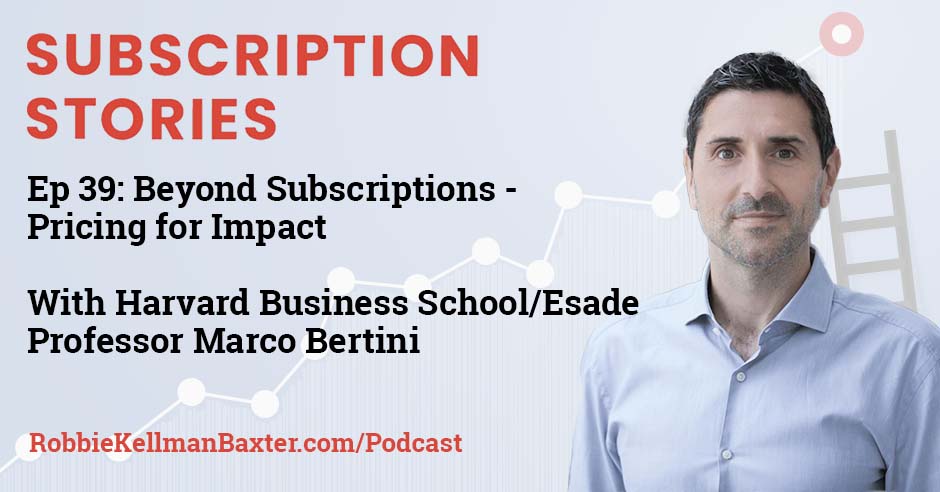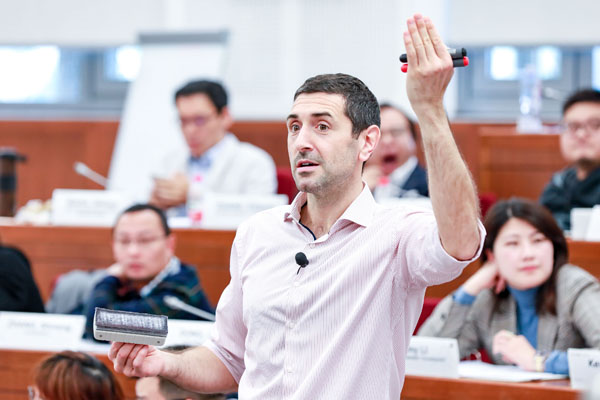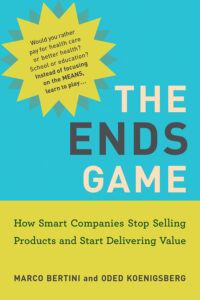
Even though people think of me as a subscription person, I always say that for me, subscriptions are simply a tactic. Subscriptions force companies to better align their pricing with performance. If the subscriber doesn’t perceive ongoing value, they cancel the subscription…so it becomes the organization’s responsibility to ensure that the customer is achieving the desired outcome. That’s the real goal of subscriptions—to better align payment with outcome.
Professor Marco Bertini is a professor at both Esade in Spain and the Harvard Business School here in the US. He is an expert on performance-based pricing—not just subscriptions, but pay-for-consumption models and even outcome-based pricing.
Marco’s new book, The Ends Game: How Smart Companies Stop Selling Products and Start Delivering Value, which he cowrote with Oded Koenigsberg of the London Business School is one of the best pricing books I’ve read in a long time. In today’s conversation, we talk about how to optimize your pricing model to ensure that your customers can access the value you provide, use your offering well, and most importantly get the performance outcomes they need. Welcome to the show, Marco.
—
Listen to the podcast here:
Beyond Subscriptions – Pricing for Impact with Harvard Business School/Esade Professor Marco Bertini
Even though people think of me as a subscription person, I always say that subscriptions are simply a tactic. Subscriptions force companies to better align their pricing with performance. If the subscriber does not perceive the ongoing value, they can cancel the subscription. It becomes the organization’s responsibility to ensure that the customer is achieving their desired outcome. That is the real goal of subscriptions, to better align payment with results.
Marco Bertini is a professor at both Esade in Spain and the Harvard Business School here in the United States. He is an expert on performance-based pricing, not just subscriptions but pay-for-consumption models, and even outcome-based pricing. Marco’s new book, The Ends Game: How Smart Companies Stop Selling Products and Start Delivering Value, which he co-wrote with Oded Koenigsberg of the London Business School, is one of the best pricing books I have read in a long time. In this conversation, we talk about how to optimize your pricing model to ensure that your customers can access the value you provide, use your offering well, and most importantly, get the performance outcomes they need.
—
Welcome to the show, Marco.
Thank you so much, Robbie, for having me. It is a great pleasure.
It is wonderful to have you. I wanted to start with a little background on you. You are a Professor. You teach and research. Can you talk a little bit about what your area of study is and the area that you teach?
I am regularly a Professor at Esade Business School, which is a school in Barcelona, Spain. I am on leave this academic year 2021 at the Harvard Business School. I am in Boston. I am coming to you from Cambridge specifically. Within that, I have always been fascinated by all the behavioral research around pricing. I mix economics, sociology and psychology. I have had training at the doctorate level in all three areas.
Believe it or not, in the many years that I have had my course, I am still struggling to find the right title for it. If I call it pricing, it is too narrow. If I call it monetization, it sounds too capitalistic. I don’t exactly know the title but I will tell you in a few words what it is. My students come to class on the first day and the same thing I would do with the executives.
The first thing I tell them is, “You all know about marketing, customers, understanding their needs and wants, and developing the jobs to be done.” Some would say developing propositions for them, a product or service. I say, “That is amazing. How do we make money off that?” That is the answer that the course tries to answer, “How do we convert all this goodness of customers into revenue for the organization?”

Pricing For Impact: To make proper pricing decisions, you need to understand the demands and supply curves.
I always emphasize, “Maybe because I want profit.” That is fine with me because I want to reinvest in my customer. It is my food. As a company, I need revenue to do stuff, whether to repay my investors, do more stuff for my customers or invest in some social, environmental initiatives. I need funds. How do I think about that question and develop something that is effective? That is what I do.
We met at the World of Business Ideas event where you were talking about this very question like, “How do you apply pricing strategy to make and manage money and run your business?” We had a lot of overlap because of your expertise in pricing, sociology, and psychology, and my work with membership models and subscription pricing very much taps into those same concepts of, “What does it mean for the people involved as well as the pricing model itself?” We were talking about the question of, “How organizations can better align pricing and business models with the impact that they have on the customer.” I am wondering, why don’t more organizations think about these kinds of issues, aligning pricing with impact? Why has this not been a hotter topic in the past?
That is the thing that I have been observing, which led me to ultimately write a book about this. It is this idea that some things are changing in the interactions that allow us to even start contemplating and putting our money where our mouth is. The number one is the technology that goes behind it. In many situations, not all situations, I am now able to measure impact in some way with some proxy through some sensor or something else that allows me to manage that risk. That uncertainty or risk in a transaction always exists. It is perceived by our customers.
The question is, “If I have a sense of performance model in the way I am getting paid as a company, I am taking down that risk, will I do it?” Yes, if I can mitigate the risk. The first step in that is having insight into what that looks like. The way I think about this and explain it to my students and managers in companies is, if you think about research that we do as a company, the first thing we discovered that we were told in business school to do as research is to understand the needs of the customer.
If you want to be customer-focused, understand what they want. It makes perfect sense. Years ago, we were told, “That is not sufficient. You also have to know how they go about making their purchase. This is the customer journey and manages the customer experience.” The research department not only needs to find out what you want but also how you go about buying things. If I know how you go about buying stuff, I can influence the decision in some way or optimize it.
What I talk about is the third wave of research, which is what happened beyond the moment of purchase. It is what we call impact data, “What happens to you and the product when you use it? What is the proxy that I can use to measure performance that is pretty solid, cannot be tampered with, and that can build a revenue model around?” Robbie, we are going to speak about this as we go in our conversation.
Let me say it upfront. I am not saying every company after you have read this blog, will go and change their revenue model to a performance metric because it is a pretty hard thing to do. Having it in your mind, given the technology that is available, will probably save you a lot of heartaches when it comes to being careful or disrupted by startups and whatnot.
That is so important what you said. Even if you don’t change your business model, don’t change your pricing structure if you spend some time understanding what the customer does after the moment of transaction, whether or not they are getting value and what kind of value they are getting from your product. If you do that, regardless of your pricing structure, you are going to have greater loyalty, engagement and trust.
Customers do business with you because they have a problem and they wish you can solve it for them. Share on XWe have talked about this before. I am completely behind what you say.
You mentioned that these ideas, you wrote a book about them. You and Oded Koenigsberg wrote this book, The Ends Game. It is focused on how organizations can build these impact-based models by focusing on that post-sales customer value. I felt like I was saying the title wrong. Before the book came out, you told me what it was called. I kept thinking I was hearing it wrong. It is called The Ends Game.
If you look at it from the customer perspective, we came up with this framework, which is what the book is based on. We hypothesized that a customer wants to do business with you because they have got a problem to solve and a job to be done. That is what they are buying. They are hopefully buying a solution. If there are going to be pain points in this transaction and towards getting the desired solution, what pain points are there?
We believe that all pain points boil down to three types. I am clearly defining the book. First of all, it is access. If you don’t have access to a solution, you will not solve your problem. Access is the first stage-gate. Once you have access, what is the next pain point? It is consumption. In order to be able to ultimately get the desired outcome, I have to have access to a solution. Hopefully, it is your solution. I have to consume it. If I don’t consume it or consume it sub-optimally, I will not get the desired outcome.
The third and last is you have the performance. You have to have access to a solution and use that solution. It has to perform in the way you would like it to perform. If you have got these three things, access, consumption, and performance, then you get your desired outcome. Having that realization, we said to ourselves, “What pain points do a classic transaction model address?” None of those, if you think about it. Selling stuff at a store is a poor way of granting access because you have to buy it upfront. It is inconvenient. There are all sorts of problems to do with access.
In my opinion, subscriptions are an amazing way to alleviate access problems, which is the first hurdle there is. We call it The Ends Game because instead of thinking about your revenue model from the means to an end, the product or service, you should be thinking about it from the ends that customers are looking for. The Ends Game is supposed to be this idea that, “You have got this access, consumption and performance continuum. You have all these different revenue models that can fall under those three things. Are you playing the game to get closer towards your customer, giving them the ends they are looking for?” That is my best summary.
You did two things there. One of them is you explained The Ends Game. It comes from this, “What is the final outcome? Do the ends justify the means in this idea of, it is like a game?” There are a lot of variables. You are trying to play it based on the hand you have been dealt, what your competitors are, and how they are playing as well. It is a very clever name. It is the idea of the ends, the means, and thinking through both parts.
You also started to dig into those steps on the way to performance-oriented pricing. Those three pain points are access, consumption, and performance, and the importance for an organization to optimize each one of those with the customer in mind. You brought up that it starts by taking a step back and saying, “That is how I need to think about things before I even start to put a price or pricing structure around it.”

The Ends Game: How Smart Companies Stop Selling Products and Start Delivering Value (Management on the Cutting Edge)
Why are these important? I purposely called them pain points before. Let us backtrack. I am a customer. I am doing business with you because I have a problem and hopefully you can solve it for me. You can sell me the product that hopefully solves the problem by selling. I might find it is hard to reach or too expensive to buy upfront like an access problem. It may sit there. I don’t use it that much because the situation does not allow me to use that much or it might not do what it is supposed to do.
These pain points have material importance to the business because any customer that perceives a pain point, we also call it risk before. There is uncertainty in that transaction. Uncertainty risk and pain point are not free. What is going to happen? People are going to stay out of the market. Even if I enter the market in case, I am going to reduce my willingness to pay because I have to cater to this uncertainty.
A simple example is either a piece of machinery or a car. It is something that is financial access. The upfront expenditure is large. By forcing people to buy expensive things upfront, clearly, the market is a lot smaller than it could be. I have profitable customers who would otherwise be profitable under a different revenue model. They are saying to themselves, “I cannot afford this upfront. I am out of this market. Me, as a business, I have to shrink my total addressable market.”
I love the example of cars. I used that example in my first book, The Membership Economy, to talk about unbundling the value of buying a car. I need to buy a car because I need to get to work. I have other options. I can take the bus or an Uber. I can rent or lease a car. I can get a taxi. Honestly, I can ride a bike, skateboard or walk. There are lots of different solutions. If I say, “I have 3 kids and 2 car seats. I need to get them around,” that adds to the complexity.
If you focus on the end-user and what their goals are, you can repackage that value. What you are pointing out is that access is the first hurdle. If you say you have to buy the car and I say, “I live in the city. I have nowhere to park it. I cannot afford to write that check,” I am out of the game, even though there is some value that could be derived from having access to some car experience.
I brought up a thought that I want to share. In the research that we conducted, one of the things surprised us but then when we saw it happening over and over again, it made sense. If you force yourself as a company to think about at some moment in time, moving my revenue model to something that is more aligned with outcomes, you know what it does. As a company, you start thinking about those outcomes a lot more because, ultimately, my money is going to come out of those.
What happens? At some magical moments, you look back and say, “My product and service are not aligned with the outcome that they are asking me to achieve. Before, I was making money on the product and that was pretty safe there. I was hoping it would do what it is supposed to do. Now that I am aligning my money with the outcome or thinking about doing so, I want to look back and make sure the products are delivering on that thing.”
If people take nothing else away from this, there have already been ten amazing nuggets of value. I feel like this is so important. It is that process of saying, “What is it that brought the customer to me? What is the outcome that they desire and hope for at that moment when they are buying from me?” If you ask yourself that question when you are building a product and thinking about support, how to talk about it, and market it, it changes everything. It is like, “I don’t go to a store to buy a blouse because I want to own a blouse. I go to a store because I want to look professional in my meeting.” If you say, “Everybody, Robbie wants to look professional. How do we help her look professional?” it changes.
Without giving direct company names, I am sure this has happened to you, too. I have helped out a couple of companies who moved away from selling a product or piece of hardware into a subscription. More than once, it had happened to me that when they started doing the subscription, I am sure you will relate to this, they look back and think to themselves, “Do I even need that product that I built my brand on? Maybe it is completely secondary. God forbid, maybe my value offering does not have to be anchored on that product anymore.”
It’s essential to understand what outcome the customers want from your product. Share on XIt is this wow moment that you think. It is interesting to me as an academic because my revenue model is changing my value offering. It goes the other way around than it typically does. Typically, you create a value offering, and then you monetize it. Now, the way I monetize is changing the value it creates. This goes backward or a feedback loop of sorts.
When you and I first met, I will always remember one of the first things you said, “You are very interesting. I don’t think subscriptions are the be-all and end-all, though.” It is provocative and interesting but it is important. What subscriptions do, though, is they are a practical means of forcing the company to rethink how they deliver value.
It becomes the forcing function to say, “I am a newspaper. Historically, I have made money by selling ads, which means I want to get as many people to read my content as possible. Now, I am making money subscribing, which means the readers are paying. Instead of making articles that a lot of people will look at, I have to write articles that fewer people are willing to pay for.” This has been surprising to a lot of the newsrooms and editorial teams. That means you have to change your content and core product if you care about the impact. If your impact is for an advertiser, it is very different than if your impact is for a reader.
If I did not apologize at that time, I would apologize now. We are always learning about these things. That response at that time was a bit naive because I was talking about metrics and you were talking about a subscription. Sometimes these two things get intermingled but it is separate at the same time. I am still wrapping my head around it.
I was not offended. I found it provocative and thought-provoking. I have got to thinking. I do always say that subscription is a pricing tactic. It is not a strategy by itself. I call it treating your customer like a member, focusing on the long-term relationship, which implies what you talked about. You have to have an impact or they are not going to come back and keep paying you.
Subscription pricing keeps you honest because if you are not delivering on that impact, the customer can cancel. It did help with my thinking. Thank you for that. You are keeping me on my feet. It is interesting because one of the things you have talked about is, “What is valuable for the customer? Why the customer wants this is clear.” You talked about the risk to the organization. What is the value to the organization?
It ties back to what we were saying before about how that risk is not free. Ultimately, what it does is, either keep customers away or shrink their willingness to pay. The corollary of that from the firm’s perspective is that, “What I have got is a smaller marketplace. It is a smaller market where there are profitable customers that stay out.” The way to see it to me is two-fold. The first fold is short-term and the second fold is more long-term.
In the short-term, I have got a shorter time. If I have got a smaller marketplace, I am not making the most of the financial opportunity in the marketplace. I am turning away profitable customers. In the longer-term, the customers are the ones who pay. They ultimately are the ones who rule. If I am trying to shove down their throats a model whereby I am focusing on the means rather than the ends and therefore I am trying to sell you something upfront, “Take the money, run to the bank and put it in my account,” that creates pain points, access, consumption and performance.

Pricing For Impact: If you have these three things: access, consumption, and performance, then you will get your desired outcome.
If somebody comes in with a revenue model that is friendlier to the customer, they are most likely going to turn to them. To me, I always see this as the heart of disruption. This is why it is longer-term. Somebody comes along and says, “The only way you can buy this particular product is if you shell a lot of money upfront but sometimes you don’t even use it. Sometimes it does not even do what it is supposed to do. Let me change this to a subscription basis so that you pay by time.”
The customer says, “At least I am paying bit by bit and I can see whether it works or not. Let me change it to a pay-per-use model because I can measure that. That is amazing because I pay whenever I use it. Let me change it to a hybrid between pay-per-use and actual performance, where there is a bit of a performance metric and some of the payments are tied to that. That is even more amazing because are you telling me that I pay you when I get satisfaction?” Most likely, a significant bunch of the customer base will migrate to somebody offering a more customer-focused revenue model. That is the short-term and long-term benefit or threat, depending on how you see it for the company.
In a perfect world, you have infinite models aligned with the outcome desired by every customer that you could possibly serve. If I am Volvo, you can buy my car or subscribe to my fleet of cars for variety. You can use me in an Uber-style and I will send you a car when you need it. You can rent or lease. There are lots of different options. That is ideal but in real life, that is messy. It is hard to run all of these different models concurrently. Even to move from transactional to subscription, I have seen it creates all kinds of messiness and challenges. What do you see as the challenge as organizations take your research to heart?
It is much easier to talk about this in a show with you than doing it in practice within a company. What is the outcome that my customers want from my product? Is there more than one? Is it just one? To what level of depth do we want to go? Is it going from A to B? Is it mobility? Is it satisfaction while you are driving? What is the level of concreteness to which I want to take depth? It is breadth and depth.
Within the outcome discussion, how do we measure it? One thing is whether there is going to be data on this but what is the actual proxy that I use to measure the outcome? If it is in a B2B context, it is slightly easier because the ultimate proxy is going to be the actual financial impact on my customer. It is nice. In a direct-to-consumer context, how do I make enjoying driving a car into an outcome? How do I measure that? Can I measure it? Is it going to be something that can be tampered with by the customer?
All these issues around understanding what the outcome is, measuring and communicating it, that is a big issue. It is one that surprised me. As an academic, I am naive. I said, “I will come easy. Decide on the metric and go for it.” When you go into companies, that is quite an issue there. I had seen companies take 5, 6 or 7 years thinking about outcomes before they even made a move.
I mentioned this a little bit before, control. Once I have my outcome and data, to what extent can I control the quality of the outcome? We are thinking to ourselves, “It is my products. Clearly, I can control the quality of an outcome.” That is not true. In all services, the customer has something to say about that outcome. Let us think back to healthcare.
I can have the best treatment or pill in the world but if the customer does not take it exactly at that time with that interval together with this other medication in these conditions, without eating a hamburger beforehand, if that does not happen, then all the effects go away and I have done nothing like a firm. How can I influence more so than control my customer if they are an active participant in the quality of an outcome to play their part?
Look backwards and re-engineer products and services to make sure they achieve the best possible outcome. Share on XIn a B2B or industrial context, for instance, the typical way they handle this is by saying, “Customer, I will do the application for you in case. I will go into your premises, insert my parts into your products and make sure everything works fine because I know how to do it properly.” It is a costly exercise but that is how often they do it. Another thing that we also mentioned is then looking backward and re-engineering products and services to make sure they achieve the best possible outcome.
Another one is the transition. That is the swallowing the fish idea. How do I think about that? Do I have multiple revenue models at the same time, as you were saying in the example of Volvo? Do I burn all the bridges, boats, and anything else I can find and move to the next one à la Adobe? How do I manage the expectations, not only within the company but also externally from a public company? The fish, even if it is a small sardine, there is a bit of depth. The costs go up in the short-term.
Swallowing the fish where your revenue goes down while your costs go up is usually frowned upon by your investors, even as they tell you to move toward customer-centricity, earning revenue, and all those things. To summarize, you brought up three good steps. The first piece is to have the right data and be able to track it, which a lot of companies, that is a big enough challenge by itself.
The second thing is to understand what the outcome is that you are driving and how you are going to use data to measure that. The last thing is ensuring control over the quality of that outcome and making sure that it happens. It is compliance, results, and all of those things. You brought up that separate point, which is so important. Cultural transformation is hard and it takes a long time. Even if it is just a sardine of change, it is painful.
One of the things that come over and over again, I am sure you have much more experience with this than I do. Even the first step in moving away from a transaction model to a subscription model, very often, is a big change in the company. Under the transaction model, the product is a profit center, “Here is a product. It has a certain margin. I want to get lots of that margin.”
If you move to a subscription, often, that product becomes a cost center because what you are making money off is a subscription and delivering in the context of subscriptions for physical products. I need to deliver that product constantly and now I am thinking to myself, “How do I bring down the costs of delivering that product?” It becomes a cost center. Good luck within a company telling people who are the profit centers of the company, the powerful people in the organization beforehand, telling them now they are a cost center.
That is one of the biggest challenges. It is the example of the news organization where the product is the news. Suddenly, you are saying, “It is not about whether your news wins prizes. It is about, whether people read your articles,” or talking to engineers and saying, “I know that you want to make a fast engine but our customers care about cup holders and car seats. Do that because that is the most important thing.”
When the nature of the product or value changes, the power shifts in the organization. People don’t like to talk about that or hit that head-on because, honestly, it is an uncomfortable conversation. It is important to greet that head-on and acknowledge that the power structure changes. The way you said it is eloquent, “Your product team is no longer the profit center. Suddenly, they are one more cost.”

Pricing For Impact: Your value offering doesn’t have to be anchored on your product.
It may be sound a lot worse. At least it is not the only profit center. Even the power dynamics in the organization changes.
Who is doing this well? When you think about an example of a company, organization or industry that is ends-focused, who is on the cutting edge?
You are going to have to excuse me on this one because I would prefer not to single out anybody who is doing it well. Many of these companies are in transition. Typically, those who tend to have cracked this a bit better are the companies that are in environments where either there is pressure to make that change because the waste that is inherent to a means model is of public importance. I am thinking of education and healthcare. They are all consequential. It is the big sectors, public policy and/or the sectors where the outcome question, measurability, and control element are easier to get around, typically B2B.
A lot of industrial goods manufacturers have known about this before. They have taken what I would call an analog approach to performance-based models. Money-back guarantee is the analog version. It is moving to these more complicated profit-sharing agreements and revenue-sharing agreements. In industrial companies and sectors, you will find a lot of that. I am thinking of medical diagnostics, mining and agriculture. There are plenty of those examples. Let us stress for the audience. We are not saying, “Tomorrow, go straight from selling a product to selling performance.”
In direct-to-consumer, it is very hard to do performance models where we are in most sectors but it is relatively easy to do consumption-based models. That is where you will find a little growth. At least, I am observing a lot of companies that have already ventured into subscriptions are starting to add a usage-based component to their subscriptions because their data is getting so much better. They realized that by having this usage-based component, they would be even more customer-focused than they were before. I don’t know if you have observed this as well.
There are two examples that pop to mind. One of them is Stitch Fix, which in the beginning, people thought of like a subscription box with some new clothes every quarter. They have moved away from subscription and more towards, “Get the box when you need it, for the occasion when you need it.” Another example is we are seeing it with a lot of the streaming video services like Amazon Prime Video.
Not only can you subscribe for whatever your monthly fee is or get it with your Prime but then they are asking you to pay if you consume specific titles early. Early access has an extra cost or access to very popular world championships and things like that. Those are two examples of companies that are going one step beyond subscription and considering multiple models to better tie pricing to impact.
I have seen it also in the SaaS world. This idea of having some usage component is booming. In the fitness industry, similarly, it is happening a lot. Prior to that, maybe you had a subscription to certain classes or whatever it was. They are adding the usage component because I may not use the gym as much as I expected to do.
Place yourself in an environment where you’re pressured to make a positive change. Share on XWe could talk all day about models and outcomes-oriented pricing in particular. Before I close out, I want to do a speed round with you. Answer the question without thinking too much. What is the first subscription you ever had?
A gym membership.
What is your favorite subscription?
What is the best business book you have read besides your own?
Besides mine?
What is an elegant business model, something that you have admired as you have done your research?

Pricing For Impact: On a subscription model, your customers pay you when they actually get satisfaction.
People have seen this. There is a comedy theater in Barcelona, Spain. It is where I usually am at. Instead of charging by the tickets and the show, as you typically would do, they decided to install a whole bunch of iPads in the back of the seat in front of you and deploy the facial recognition software to understand when you are smiling. They started charging the audience by the number of smiles because it is a comedy theater. It is a performance metric. It was €0.40 per smile with a cap of €20.
That is a bargain. I would pay €0.40 for a smile.
It is super clever.
Marco Bertini, thank you so much for being on the show. I look forward to talking to you again.
Thank you very much.
—
That was Harvard Business School and Esade Professor, Marco Bertini, co-author of The Ends Game: How Smart Companies Stop Selling Products and Start Delivering Value. For more about Marco, go to MarcoBertini.com. For more about subscription stories, go to RobbieKellmanBaxter.com/podcast. If you like what you read, please go over to Apple Podcasts or Apple iTunes and leave a review. Mention Marco and this episode if you especially enjoyed it. We read all the reviews because we want your feedback. Thanks for your support and thanks for reading.
Important Links
- Marco Bertini, Professor of Marketing, Esade and Harvard Business School
- Esade
- Harvard Business School
- The Ends Game: How Smart Companies Stop Selling Products and Start Delivering Value
- London Business School
- World of Business Ideas
- Oded Koenigsberg, Professor of Marketing, London Business School
- The Membership Economy
- Uber
- Volvo
- Adobe
- Stitch Fix
- Amazon Prime Video
- Netflix
- The Forever Transaction
- Buy Fooled by Randomness on Amazon
- Apple Podcasts – Subscription Stories: True Tales from the Trenches
About Marco Bertini
 Marco Bertini is professor of marketing at Esade and a visiting professor at Harvard Business School. He is also a senior advisor to the marketing, sales, and pricing practice at the Boston Consulting Group. He received his doctorate from Harvard Business School, and previously served on the faculty at London Business School.
Marco Bertini is professor of marketing at Esade and a visiting professor at Harvard Business School. He is also a senior advisor to the marketing, sales, and pricing practice at the Boston Consulting Group. He received his doctorate from Harvard Business School, and previously served on the faculty at London Business School.
Marco is co-author of the book The Ends Game: How Smart Companies Stop Selling Products and Start Delivering Value (MIT Press), which explores how modern technology stimulates accountability, challenging organizations to succeed from the quality of the outcomes they deliver rather than the offerings they bring to market.
The remainder of his research, which lies at the interface of the economics and psychology of pricing decisions, appears in the leading journals for management science and practice, including Harvard Business Review, MIT Sloan Management Review, Journal of Consumer Research, Journal of Marketing, Journal of Marketing Research, and Marketing Science.
Marco’s speaking and advisory work focuses on the challenge of designing and implementing revenue policies that not only drive strong growth, but also are socially responsible. Recently, Marco was named to the Thinkers50 Radar, a shortlist of the scholars “most likely to shape the future of how organizations are managed and led.” Prior to this, he was nominated for the Business Professor of the Year Award, a global competition of the Economist Intelligence Unit, and recognized by the Marketing Science Institute as one of the most promising scholars in the field.
Marco is Italian but grew up in Australia and subsequently lived in Spain, the United States, the United Kingdom, and now back in Spain. For more information, please visit www.marcobertini.com.
Love the show? Subscribe, rate, review, and share!
Join the Subscription Stories Community today:


